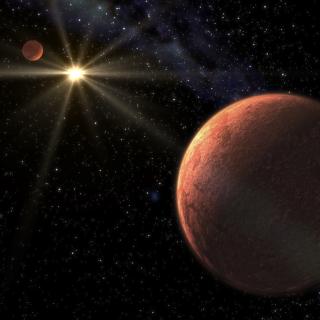Bibcode
Damasso, M.; Rodrigues, J.; Castro-González, A.; Lavie, B.; Davoult, J.; Zapatero Osorio, M. R.; Dou, J.; Sousa, S. G.; Owen, J. E.; Sossi, P.; Adibekyan, V.; Osborn, H.; Leinhardt, Z.; Alibert, Y.; Lovis, C.; Delgado Mena, E.; Sozzetti, A.; Barros, S. C. C.; Bossini, D.; Ziegler, C.; Ciardi, D. R.; Matthews, E. C.; Carter, P. J.; Lillo-Box, J.; Suárez Mascareño, A.; Cristiani, S.; Pepe, F.; Rebolo, R.; Santos, N. C.; Allende Prieto, C.; Benatti, S.; Bouchy, F.; Briceño, C.; Di Marcantonio, P.; D'Odorico, V.; Dumusque, X.; Egger, J. A.; Ehrenreich, D.; Faria, J.; Figueira, P.; Génova Santos, R.; Gonzales, E. J.; González Hernández, J. I.; Law, N.; Lo Curto, G.; Mann, A. W.; Martins, C. J. A. P.; Mehner, A.; Micela, G.; Molaro, P.; Nunes, N. J.; Palle, E.; Poretti, E.; Schlieder, J. E.; Udry, S.
Bibliographical reference
Astronomy and Astrophysics
Advertised on:
11
2023
Journal
Citations
17
Refereed citations
15
Description
Context. One of the goals of the Echelle Spectrograph for Rocky Exoplanets and Stable Spectroscopic Observations (ESPRESSO) Guaranteed Time Observations (GTO) consortium is the precise characterisation of a selected sample of planetary systems discovered by TESS. One such target is the K0V star HIP 29442 (TOI-469), already known to host a validated sub-Neptune companion TOI-469.01, which we followed-up with ESPRESSO.
Aims: We aim to verify the planetary nature of TOI-469.01 by obtaining precise mass, radius, and ephemeris, and constraining its bulk physical structure and composition.
Methods: Following a Bayesian approach, we modelled radial velocity and photometric time series to measure the dynamical mass, radius, and ephemeris, and to characterise the internal structure and composition of TOI-469.01.
Results: We confirmed the planetary nature of TOI-469.01 (now renamed HIP 29442 b), and thanks to the ESPRESSO radial velocities we discovered two additional close-in companions. Through an in-depth analysis of the TESS light curve, we could also detect their low signal-to-noise transit signals. We characterised the additional companions, and conclude that HIP 29442 is a compact multi-planet system. The three planets have orbital periods Porb,b = 13.63083 ± 0.00003, Porb,c = 3.53796 ± 0.00003, and Porb,d = 6.42975−0.00010+0.00009 days, and we measured their masses with high precision: mp,b = 9.6 ± 0.8 M⊕, mp,c = 4.5 ± 0.3 M⊕, and mp,d = 5.1 ± 0.4 M⊕. We measured radii and bulk densities of all the planets (the 3σ confidence intervals are shown in parentheses): Rp,b = 3.48−0.08(−0.28)+0.07(+0.19) R⊕ and ρp,b = 1.3 ± 0.2(0.3)g cm−3; Rp,c = 1.58−0.11(−0.34)+0.10(+0.30) R⊕ and ρp,c = 6.3−1.3(−2.7)+1.7(+6.0)g cm−3; Rp,d = 1.37 ± 0.11(−0.43)(+0.32) R⊕ and ρp,d = 11.0−2.4(−6.3)+3.4(+21.0)g cm−3. Due to noisy light curves, we used the more conservative 3σ confidence intervals for the radii as input to the interior structure modelling. We find that HIP 29442 b appears as a typical sub-Neptune, likely surrounded by a gas layer of pure H-He with amass of 0.27−0.17+0.24 M⊕ and a thickness of 1.4 ± 0.5 R⊕. For the innermost companions HIP 29442 c and HIP 29442 d, the model supports an Earth-like composition.
Conclusions: The compact multi-planet system orbiting HIP 29442 offers the opportunity to study simultaneously planets straddling the gap in the observed radius distribution of close-in small-size exoplanets. High-precision photometric follow-up is required to obtain more accurate and precise radius measurements, especially for planets c and d. This, together with our determined high-precision masses, will provide the accurate and precise bulk structure of the planets, and enable an accurate investigation of the system's evolution.
Aims: We aim to verify the planetary nature of TOI-469.01 by obtaining precise mass, radius, and ephemeris, and constraining its bulk physical structure and composition.
Methods: Following a Bayesian approach, we modelled radial velocity and photometric time series to measure the dynamical mass, radius, and ephemeris, and to characterise the internal structure and composition of TOI-469.01.
Results: We confirmed the planetary nature of TOI-469.01 (now renamed HIP 29442 b), and thanks to the ESPRESSO radial velocities we discovered two additional close-in companions. Through an in-depth analysis of the TESS light curve, we could also detect their low signal-to-noise transit signals. We characterised the additional companions, and conclude that HIP 29442 is a compact multi-planet system. The three planets have orbital periods Porb,b = 13.63083 ± 0.00003, Porb,c = 3.53796 ± 0.00003, and Porb,d = 6.42975−0.00010+0.00009 days, and we measured their masses with high precision: mp,b = 9.6 ± 0.8 M⊕, mp,c = 4.5 ± 0.3 M⊕, and mp,d = 5.1 ± 0.4 M⊕. We measured radii and bulk densities of all the planets (the 3σ confidence intervals are shown in parentheses): Rp,b = 3.48−0.08(−0.28)+0.07(+0.19) R⊕ and ρp,b = 1.3 ± 0.2(0.3)g cm−3; Rp,c = 1.58−0.11(−0.34)+0.10(+0.30) R⊕ and ρp,c = 6.3−1.3(−2.7)+1.7(+6.0)g cm−3; Rp,d = 1.37 ± 0.11(−0.43)(+0.32) R⊕ and ρp,d = 11.0−2.4(−6.3)+3.4(+21.0)g cm−3. Due to noisy light curves, we used the more conservative 3σ confidence intervals for the radii as input to the interior structure modelling. We find that HIP 29442 b appears as a typical sub-Neptune, likely surrounded by a gas layer of pure H-He with amass of 0.27−0.17+0.24 M⊕ and a thickness of 1.4 ± 0.5 R⊕. For the innermost companions HIP 29442 c and HIP 29442 d, the model supports an Earth-like composition.
Conclusions: The compact multi-planet system orbiting HIP 29442 offers the opportunity to study simultaneously planets straddling the gap in the observed radius distribution of close-in small-size exoplanets. High-precision photometric follow-up is required to obtain more accurate and precise radius measurements, especially for planets c and d. This, together with our determined high-precision masses, will provide the accurate and precise bulk structure of the planets, and enable an accurate investigation of the system's evolution.
Related projects

Very Low Mass Stars, Brown Dwarfs and Planets
Our goal is to study the processes that lead to the formation of low mass stars, brown dwarfs and planets and to characterize the physical properties of these objects in various evolutionary stages. Low mass stars and brown dwarfs are likely the most numerous type of objects in our Galaxy but due to their low intrinsic luminosity they are not so
Rafael
Rebolo López

Exoplanets and Astrobiology
The search for life in the universe has been driven by recent discoveries of planets around other stars (known as exoplanets), becoming one of the most active fields in modern astrophysics. The growing number of new exoplanets discovered in recent years and the recent advance on the study of their atmospheres are not only providing new valuable
Enric
Pallé Bago